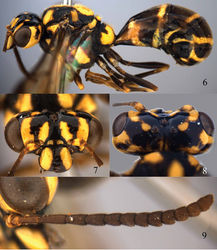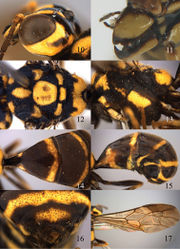Bakeronymus seidakka
| Notice: | This page is derived from the original publication listed below, whose author(s) should always be credited. Further contributors may edit and improve the content of this page and, consequently, need to be credited as well (see page history). Any assessment of factual correctness requires a careful review of the original article as well as of subsequent contributions.
If you are uncertain whether your planned contribution is correct or not, we suggest that you use the associated discussion page instead of editing the page directly. This page should be cited as follows (rationale):
Citation formats to copy and paste
BibTeX: @article{Chen2014ZooKeys385, RIS/ Endnote: TY - JOUR Wikipedia/ Citizendium: <ref name="Chen2014ZooKeys385">{{Citation See also the citation download page at the journal. |
Ordo: Hymenoptera
Familia: Trigonalyidae
Genus: Bakeronymus
Name
Bakeronymus seidakka Yamane & Terayama, 1983 re-instated – Wikispecies link – Pensoft Profile
- Bakeronymus typicus seidakka Yamane & Terayama, 1983: 169; Weinstein and Austin 1991[1]: 418; Carmean and Kimsey 1998[2]: 59.
Type material
Paratype, + (RMNH), “[China:] Taiwan, Nantou county, Renai town, Nanfeng village”, “[collected] 12.VIII.1980, r[eared] from Parapolybia varia, emer[ged] 14–16.VIII.[1980], M. Terayama”, “Paratype + Bakeronymus typicus seidakka ssp. n. Yamane et Terayama, 1983”. The holotype + (HUS) and 2 + paratypes (Yamane Collecton, Kagoshima University) are not examined.
Diagnosis
Eyes remain distinctly separated from mandibular condyli; fourth antennal segment slightly widened apically; middle lobe of mesoscutum with large yellow patch; truncate apical part of scutellum 0.7 times as wide as scutellum anteriorly; fore wing with three submarginal cells; apical half of hind basitarsus ivory; propodeum reticulate-rugose, with short rugae interconnecting transverse rugae.
Description
Female paratype, length of body 10.1 mm (of fore wing 9.3 mm).
Head. Antenna with 14 segments; frons and vertex smooth and strongly shiny (Fig. 7), glabrous; head gradually narrowed behind eyes (Fig. 8); temple smooth and strongly shiny; occipital carina narrow medio-dorsally; supra-antennal elevations hardly developed as a thin rim and smooth; clypeus slightly protruding and thin medio-ventrally.
Mesosoma. Length of mesosoma 1.2 times its height (Fig. 13); mesopleuron densely and finely rugulose, anteriorly mixed with distinct rugae, dull; transverse mesopleural groove narrow and finely crenulate; notauli medium-sized and distinctly crenulate; mesoscutum largely reticulate-rugose and matt, contrasting with shiny head (Fig. 12); scutellar sulcus absent medially, narrow and crenulate laterally; scutellum reticulate-rugulose, convex and somewhat above level of mesoscutum; metanotum medially protruding, obtuse and medially smooth (Fig. 12); propodeum largely reticulate-rugose (Fig. 12).
Metasoma. First tergite 0.9 times as long as apically wide, gradually narrowed basally, with large elliptical depression medially and concave apically; second tergite and sternite smooth; hypopygium incised apically.
Colour. Blackish brown or dark brown with rich yellow pattern (including mesopleuron; Figs 6, 9, 12, 13, 15); palpi and antenna (except largely yellow scapus) rather dark brown; patch on coxae, fore and middle trochanters partly, apex of fore and middle femora, fore tibia, base of middle and hind tibiae, all tarsi more or less pale yellow; pterostigma and marginal cell of fore wing and surroundings dark brown; remainder of wing membrane slightly infuscate.
Male. Unknown.
Biology
Reared from nest of Parapolybia varia (Fabricius) (Polistinae: Vespidae) in Taiwan (Yamane and Terayama 1983[3]). Collected in August.
Distribution
China (Taiwan).
Notes
Only one species is known from China: Bakeronymus seidakka Yamane & Terayama, 1983, re-instated. It was described as a subspecies of Bakeronymus typicus Rohwer, 1922, from the Philippines, but comparison with specimens of this species with a paratype of Bakeronymus seidakka shows considerable differences. For instance, the middle lobe of mesoscutum is entirely dark brown; the truncate apical part of the scutellum half as wide as the scutellum anteriorly; the fore wing has only two submarginal cells; the apical half of hind basitarsus is dark brown; the eyes are close to the mandibular condyli; the fourth antennal segment is distinctly widened apically and the propodeum has transverse rugae, without short interconnecting rugae. Therefore, we treat the taxon from Taiwan as an independent species, despite that some of the differences may be sex-related (e.g. the distance between the eye and the mandibular condylus).
Taxon Treatment
- Chen, H; van Achterberg, C; He, J; Xu, Z; 2014: A revision of the Chinese Trigonalyidae (Hymenoptera, Trigonalyoidea) ZooKeys, 385: 1-207. doi
Other References
- ↑ Weinstein P, Austin A (1991) The host relationships of trigonalyid wasps (Hymenoptera: Trigonalyidae), with a review of their biology and catalogue to world species. Journal of Natural History 25(2): 399–433. doi: 10.1080/00222939100770281
- ↑ Carmean D, Kimsey L (1998) Phylogenetic revision of the parasitoid wasp family Trigonalidae (Hymenoptera). Systematic Entomology 23: 35–76. doi: 10.1046/j.1365-3113.1998.00042.x
- ↑ Yamane S, Terayama M (1983) Description of a new subspecies of Bakeronymus typicus Rohwer parasitic on the social wasp Parapolybia varia Fabricius in Taiwan (Hymenoptera: Trigonalidae). Memoirs of the Kagoshima University Research Center for the South Pacific 3: 169-173.
Images
|

